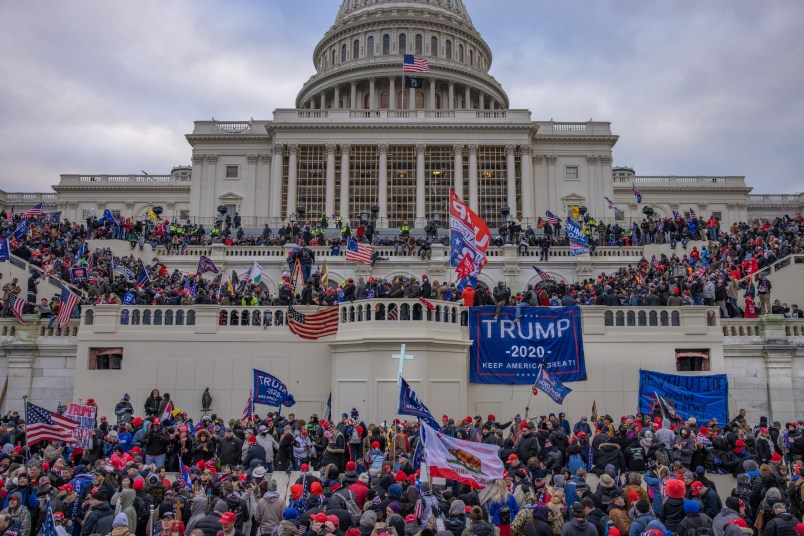To extremism researchers with decades of experience in the business of identifying and understanding right-wing extremist groups with the potential for violence, last week marked a turning point.
While many in the crowd that laid siege to the Capitol Building carried the familiar markers of extremist groups well-known to researchers — neo-Nazis, Proud Boys, Oath Keepers and and other assorted white nationalist outfits — multiple analysts told TPM that the attack sharpened their focus on a broader threat: Otherwise unaffiliated Trump supporters willing to carry out acts of violence for their leader.
Trump’s racist and anti-democratic political appeals have in many ways defined his presidency, and have long prompted white nationalist groups to rally to his side. But last week, thousands who don’t identify with any organized racist or anti-government groups acted on his command.
“The most important thing that the storming of the Capitol represents is, essentially, the culmination of something that has been developing for some time: a new extremist movement, centered around the cult of personality of Trump,” said Mark Pitcavage, a senior research fellow at the Anti-Defamation League’s Center on Extremism with decades of experience analyzing radical groups.
Not all Trump supporters are extremists, “but the fact is, a bunch of people who took part in that didn’t have connections to other extremist movements,” Pitcavage said. “They were themselves extreme Trump supporters.”
In this sense, the largely white mob that attacked the legislature was part of a broader movement that is composed of both defined groups and individuals who share Trump’s racist grievances and thrive on his conspiracy-mongering.
“There are a lot of people that I would classify as being on the far-right who are not formally part of any groups,” said Sam Jackson, an assistant professor at the University of Albany who’s tracked the Oath Keepers and others on the far right.
“Those people are worth paying attention to just as much as any of the actual, specific groups, and I think the events at the Capitol last Wednesday illustrate that really well,” Jackson said.
Cassie Miller, a senior research analyst at the Southern Poverty Law Center (SPLC), said she didn’t have a singular label for the Trump-motivated extremists involved in the attack on Congress. But she stressed that the event was years in the making.
Wednesday, she said, marked an instance of Trump supporters “demonstrating their own power to themselves.”
“These are people who for years have been told that Trump is their only representative, and he’s their only connection to the political process and to government,” Miller said. “With him no longer the President, what does that mean for them? Suddenly they are detached from the mainstream political process, and that means they are going to likely reconfigure their tactics.”
“They went and they literally seized a Capitol building,” she added. “That’s a really powerful message, and I think that they have proven to themselves that they can be an impactful movement if they want to be.”
The blurred lines between Trump supporters and those in specific extremist groups Wednesday marked a new and “more dangerous” phase of extremism in America, said Daryl Johnson, a former domestic terrorism analyst at the Department of Homeland Security.
“Now, we’ve got even more people on the outer periphery being sucked into this funnel of extremism and radicalization, being drawn out at their own expense at great distances, coming to these rallies at the President’s call and consuming disinformation.”
“That’s a big, big development,” he said. “It’s pretty sophisticated, and it’s bearing some dangerous results.”
Pitcavage, the Anti-Defamation League analyst, said he and his colleagues, “like everybody else, are trying to grasp this.”
“Not only are we looking at all of the extremists whom we traditionally monitor and are concerned about, but now there are, in addition to all that, a large number of people angry and essentially radicalized over Trump,” he said. “We’re trying to understand this phenomenon.”
Miller echoed that sentiment. SPLC, she said, has long tried to bring attention to white nationalist and other violent extremist groups. “In some ways, I think we’re trying to figure out exactly what our role is,” she said. “We have been studying something that at one point was a fringe movement, and it no longer is. What we study has fundamentally changed as the political landscape has shifted over the past four years. It’s very difficult at this point to make any real distinctions from the rhetoric of extremists on the far right and that of Trump supporters.”
“These are people who are no longer just trying to change our political priorities or elect more extreme candidates,” Miller added. “What they want to do is fundamentally change our system of government and push forward a more authoritarian form of politics.”







IOW: WHITE SUPREMACIST TERRORISM HAS BEEN OUR MOST MAJOR THREAT SINCE OKLAHOMA CITY MURRAH BUILDING 9/11 NOTWITHSTANDING.
Sure woulda been great if thousands of people had been screaming that at the Executive Branch ever since Bush I. /snark
This article doesn’t mention white supremacist terrorism ONCE. I’m very disappointed in this piece. How are we supposed to move forward as a country if people continue to pretend it’s a huge mystery what the connecting factor is for all these extremists?
Dear ‘Experts’
The GOP is a cult. The Southern Strategy and 30-plus years of rage media have created a hate mega-group whose anger must be fed.
“Traitors”?
Magahideen?